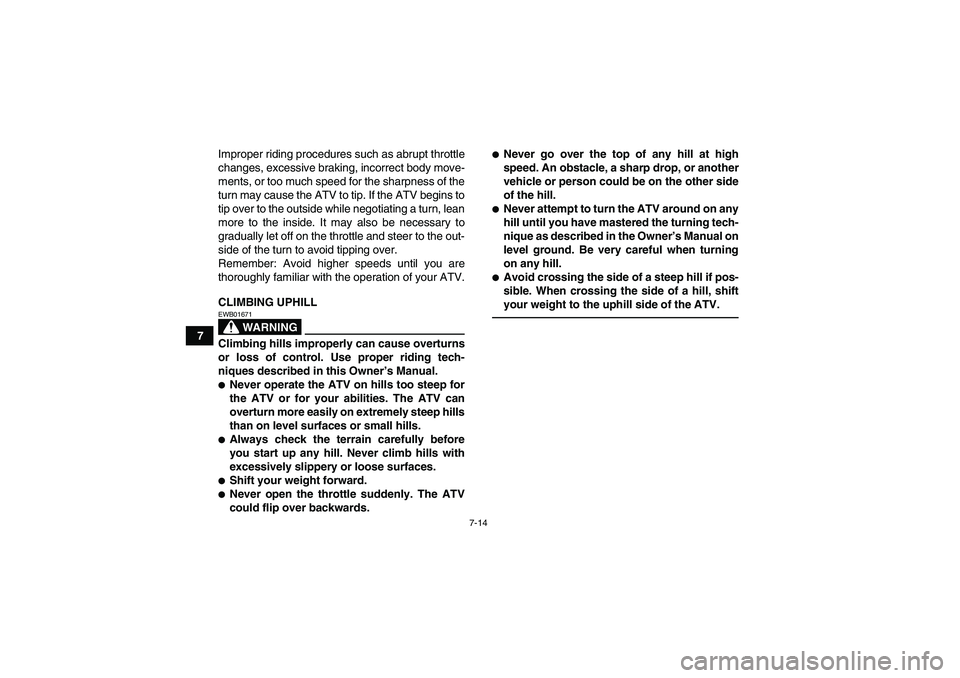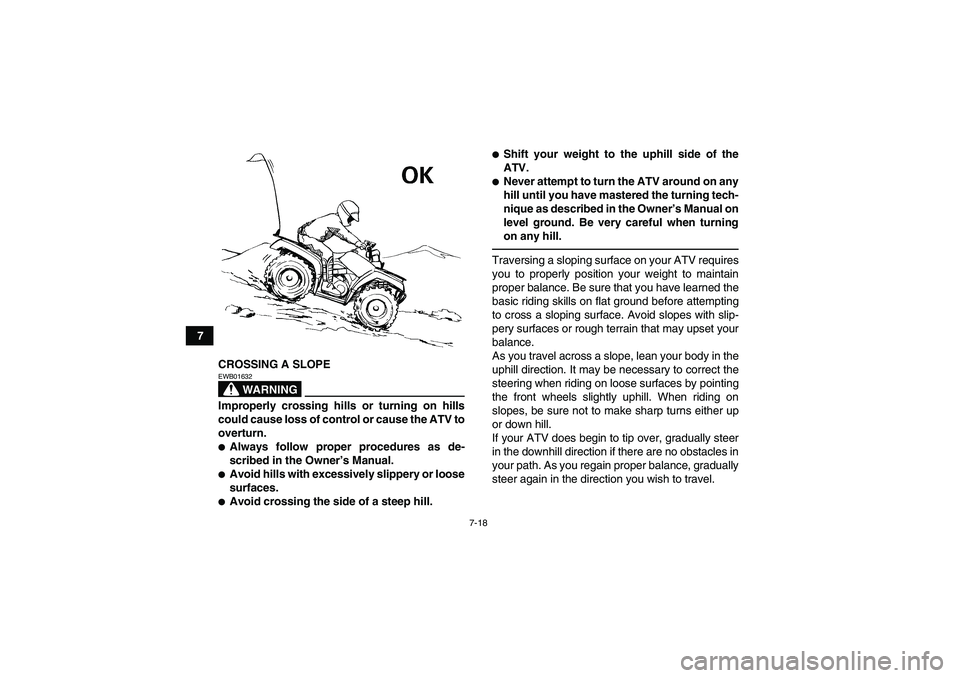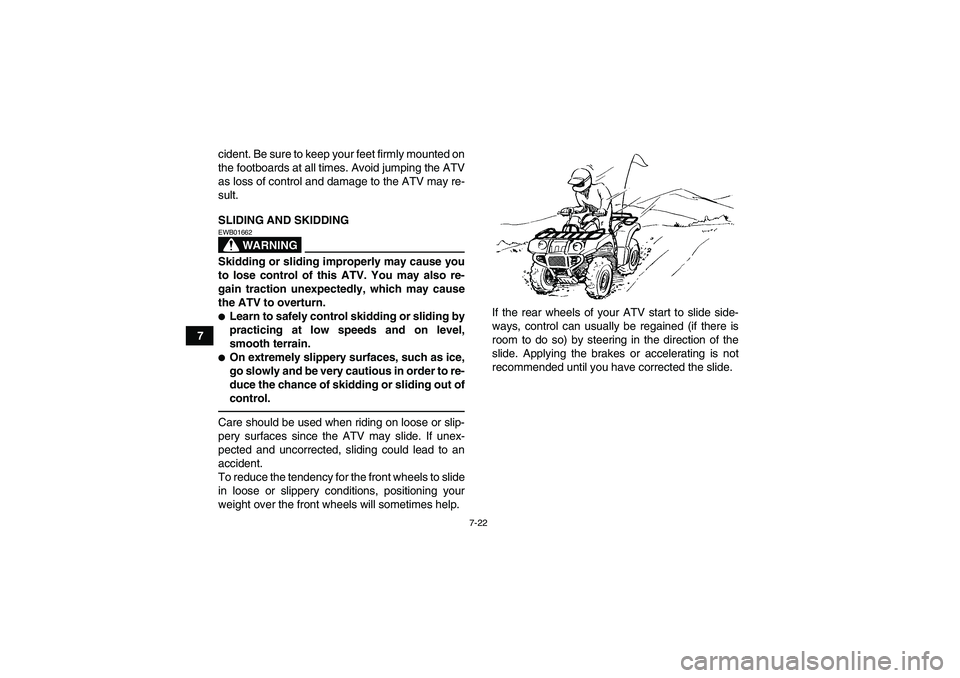Page 78 of 168

7-12
7Do not ride in areas posted “no trespassing”.
Do not ride on private property without getting per-
mission.
Select a large, flat, unpaved area to become famil-
iar with your ATV. Make sure that this area is free
of obstacles and other riders. You should practice
control of the throttle, brakes, shifting procedures,
and turning techniques in this area before trying
more difficult terrain.
Shift to the park position and follow the instruction
on page 6-1 to start the engine. Once it has
warmed up you are ready to begin riding your ATV.
With the engine idling, shift the drive select lever
into the low-range position or the high-range posi-
tion. Apply the throttle slowly and smoothly.The centrifugal clutch will engage and you will start
to accelerate. If the throttle is applied too abruptly,
the front wheels may lift off the ground, resulting in
a loss of directional control. Avoid higher speeds
until you are thoroughly familiar with the operation
of your ATV.
When slowing down or stopping, release the throt-
tle and apply the brakes smoothly and evenly. Im-
proper use of the brakes can cause the tires to lose
traction, reducing control and increasing the possi-
bility of an accident.
NOTICEECB00251Do not shift from low-range to high-range or
vice versa without coming to a complete stop.
Damage to the engine or drive train may occur.TURNING YOUR ATV
WARNING
EWB01771Always follow proper procedures for turning
as described in this Owner’s Manual. Practice
turning at low speeds before attempting to turn
U43P62E0.book Page 12 Tuesday, February 17, 2009 1:09 PM
Page 80 of 168

7-14
7Improper riding procedures such as abrupt throttle
changes, excessive braking, incorrect body move-
ments, or too much speed for the sharpness of the
turn may cause the ATV to tip. If the ATV begins to
tip over to the outside while negotiating a turn, lean
more to the inside. It may also be necessary to
gradually let off on the throttle and steer to the out-
side of the turn to avoid tipping over.
Remember: Avoid higher speeds until you are
thoroughly familiar with the operation of your ATV.
CLIMBING UPHILL
WARNING
EWB01671Climbing hills improperly can cause overturns
or loss of control. Use proper riding tech-
niques described in this Owner’s Manual.�Never operate the ATV on hills too steep for
the ATV or for your abilities. The ATV can
overturn more easily on extremely steep hills
than on level surfaces or small hills.�Always check the terrain carefully before
you start up any hill. Never climb hills with
excessively slippery or loose surfaces.�Shift your weight forward.�Never open the throttle suddenly. The ATV
could flip over backwards.
�Never go over the top of any hill at high
speed. An obstacle, a sharp drop, or another
vehicle or person could be on the other side
of the hill.�Never attempt to turn the ATV around on any
hill until you have mastered the turning tech-
nique as described in the Owner’s Manual on
level ground. Be very careful when turning
on any hill.�Avoid crossing the side of a steep hill if pos-
sible. When crossing the side of a hill, shift
your weight to the uphill side of the ATV.
U43P62E0.book Page 14 Tuesday, February 17, 2009 1:09 PM
Page 82 of 168

7-16
7If you are climbing a hill and you find that you have
not properly judged your ability to make it to the
top, you should turn the ATV around while you still
have forward motion (provided you have the room
to do so) and go down the hill.
If your ATV has stalled or stopped and you believe
you can continue up the hill, restart carefully to
make sure you do not lift the front wheels which
could cause you to lose control. If you are unable
to continue up the hill, dismount the ATV on the up-
hill side. Physically turn the ATV around and then
descend the hill.
If you start to roll backwards, DO NOT apply either
brake abruptly. If you are in “2WD”, apply only the
front brake. When fully stopped, apply the rear
brake as well, and then shift to the park position. If
you are in “4WD”, because all wheels are intercon-
nected by the drive train, applying either brake will
brake all wheels, therefore, avoid sudden applica-
tion of either the front or rear brake as the wheels
on the uphill side could come off the ground. The
ATV could easily tip over backwards. Apply both
the front and rear brakes gradually. When fully
stopped, lock shift to the park position and dis-
mount the ATV immediately on the uphill side. Dis-
mount on uphill side or to a side if pointed straightuphill. Turn the ATV around and remount, following
the procedure described in the Owner’s Manual.
WARNING! Stalling, rolling backwards or im-
properly dismounting while climbing a hill
could result in ATV overturning. If you cannot
control the ATV, dismount immediately on the
uphill side.
[EWB01802]
RIDING DOWNHILL
WARNING
EWB01621Going down a hill improperly could cause
overturns or loss of control. Always follow
proper procedures for going down hills as de-
scribed in this Owner’s Manual.
U43P62E0.book Page 16 Tuesday, February 17, 2009 1:09 PM
Page 84 of 168

7-18
7
CROSSING A SLOPE
WARNING
EWB01632Improperly crossing hills or turning on hills
could cause loss of control or cause the ATV to
overturn.�Always follow proper procedures as de-
scribed in the Owner’s Manual.�Avoid hills with excessively slippery or loose
surfaces.�Avoid crossing the side of a steep hill.
�Shift your weight to the uphill side of the
ATV.�Never attempt to turn the ATV around on any
hill until you have mastered the turning tech-
nique as described in the Owner’s Manual on
level ground. Be very careful when turning
on any hill.Traversing a sloping surface on your ATV requires
you to properly position your weight to maintain
proper balance. Be sure that you have learned the
basic riding skills on flat ground before attempting
to cross a sloping surface. Avoid slopes with slip-
pery surfaces or rough terrain that may upset your
balance.
As you travel across a slope, lean your body in the
uphill direction. It may be necessary to correct the
steering when riding on loose surfaces by pointing
the front wheels slightly uphill. When riding on
slopes, be sure not to make sharp turns either up
or down hill.
If your ATV does begin to tip over, gradually steer
in the downhill direction if there are no obstacles in
your path. As you regain proper balance, gradually
steer again in the direction you wish to travel.
U43P62E0.book Page 18 Tuesday, February 17, 2009 1:09 PM
Page 85 of 168
7-19
7
CROSSING THROUGH SHALLOW WATER
WARNING
EWB01641Operating this vehicle through deep or fast-
flowing water can lead to loss of control or an
overturn. To reduce your risk of drowning or
other injuries, use care when crossing through
water. Never operate this ATV water deeper
than the depth specified in your Owner’s Man-
ual, as tires may float, increasing the risk of an
overturn.
The ATV can be used to cross slow moving, shal-
low water of up to a maximum of 35 cm (14 in) in
depth. Before entering the water, choose your path
carefully. Enter where there is no sharp drop off,
and avoid rocks or other obstacles which may be
slippery or upset the ATV. Drive slowly and care-
fully.
Test your brakes after leaving the water. If neces-
sary, apply them several times to let friction dry out
the linings. Do not continue to ride your ATV with-
out verifying that you have regained proper braking
U43P62E0.book Page 19 Tuesday, February 17, 2009 1:09 PM
Page 86 of 168
7-20
7ability. WARNING! Wet brakes may have re-
duced stopping ability, which could cause loss
of control.
[EWB02621]
After riding your ATV in water, be sure to drain the
trapped water by removing the check hoses at the
bottom of the air filter case. Also, remove the drain
plugs from the front and rear storage compart-
ments and the V-belt case to drain any water that
may have accumulated. NOTICE: Undrained wa-
ter can cause damage or improper operation.[ECB00841]Wash the ATV in fresh water if it has been operat-
ed in salt water or muddy conditions.
1. Air filter case check hose
1. Air filter case check hose
U43P62E0.book Page 20 Tuesday, February 17, 2009 1:09 PM
Page 87 of 168
7-21
7 RIDING OVER ROUGH TERRAIN
WARNING
EWB01651Riding improperly over obstacles could cause
loss of control or a collision. Before operating
in a new area, check for obstacles. Never at-
tempt to ride over large obstacles, such as
large rocks or fallen trees. When you go over
obstacles, always follow proper procedures as
described in the Owner’s Manual.Riding over rough terrain should be done with cau-
tion. Look out for obstacles which could cause
damage to the ATV or could lead to an upset or ac-
1. Storage compartment drain plug
1. Storage compartment drain plug
1. V-belt case drain plug
U43P62E0.book Page 21 Tuesday, February 17, 2009 1:09 PM
Page 88 of 168

7-22
7cident. Be sure to keep your feet firmly mounted on
the footboards at all times. Avoid jumping the ATV
as loss of control and damage to the ATV may re-
sult.
SLIDING AND SKIDDING
WARNING
EWB01662Skidding or sliding improperly may cause you
to lose control of this ATV. You may also re-
gain traction unexpectedly, which may cause
the ATV to overturn.�Learn to safely control skidding or sliding by
practicing at low speeds and on level,
smooth terrain.�On extremely slippery surfaces, such as ice,
go slowly and be very cautious in order to re-
duce the chance of skidding or sliding out of
control.Care should be used when riding on loose or slip-
pery surfaces since the ATV may slide. If unex-
pected and uncorrected, sliding could lead to an
accident.
To reduce the tendency for the front wheels to slide
in loose or slippery conditions, positioning your
weight over the front wheels will sometimes help.If the rear wheels of your ATV start to slide side-
ways, control can usually be regained (if there is
room to do so) by steering in the direction of the
slide. Applying the brakes or accelerating is not
recommended until you have corrected the slide.U43P62E0.book Page 22 Tuesday, February 17, 2009 1:09 PM